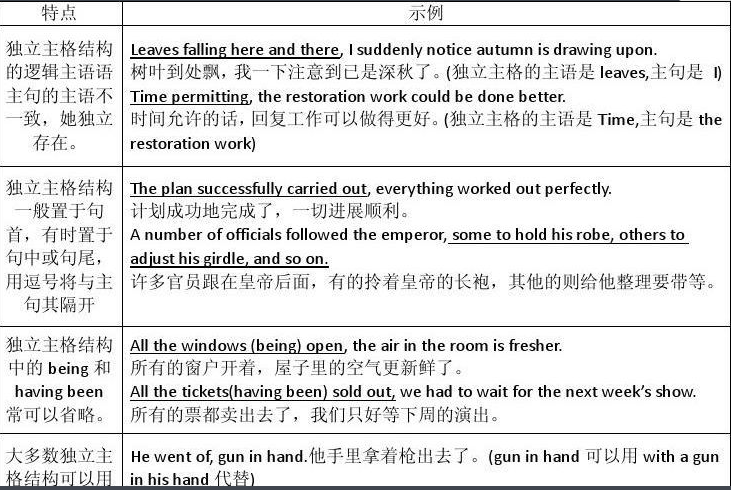独立主格结构到底是什么意思啊
独立主格结构(Absolute Construction)由两部分组成,前一部分是名词或者代词,后一部分是非谓语动词(不定式、现在分词、过去分词)或形容词、副词、名词或介词短语。前后两部分具有逻辑主谓关系。
在英语中,动词按作用和功能主要分为两大类,一类是谓语动词,另一类是非谓语动词。独立主格结构在句中作状语,多用于书面语。 独立主格结构本身不是句子,在句子中作状语,表时间、原因、条件、伴随、目的及状态等。
扩展资料:
用法:
独立主格结构主要表示谓语动词发生的时间、原因、条件或伴随情况等,相当于一个状语从句或并列句。
【1】用作时间状语
The work done(=After the work had been done), we went home. 工作完成后,我们就回家了。
【2】用作条件状语
Weather permitting(=If weather permits), they will go on an outing to the beach tomorrow. 如果天气允许的话,他们将在明天组织一次海滨小游。
【3】用作原因状语
An important lecture to be given tomorrow(=As an important lecture will be given tomorrow), the professor has to stay up late into the night. 因为明天要发表一个重要的演讲,教授不得不熬夜到很晚。
【4】用作伴随状语
He was lying on the grass,his hands crossed under his head(=and his hands were crossed under his head).他躺在草地上,将两手交叉枕在脑后。
【5】用作补充说明
We redoubled our efforts,each man working like two. 我们加倍努力,一个人干两个人的活。
*注:独立主格结构表示时间、条件或原因时,相当于一个状语从句,一般放在句首,表示原因时还可放在句末;表伴随状况或补充说明时,相当于一个并列句,通常放于句末。
